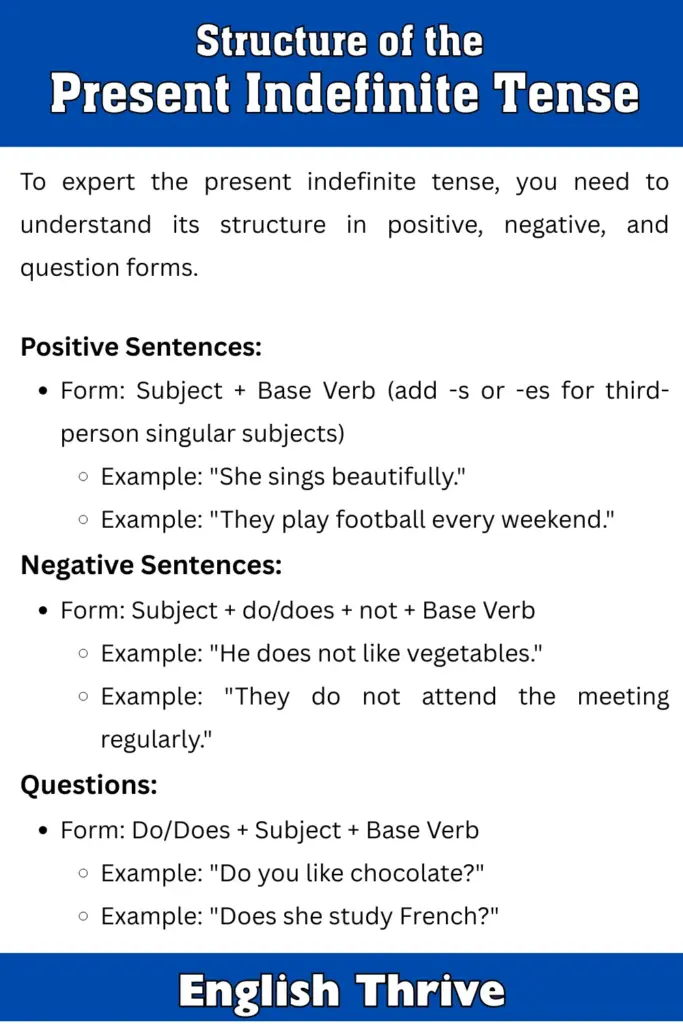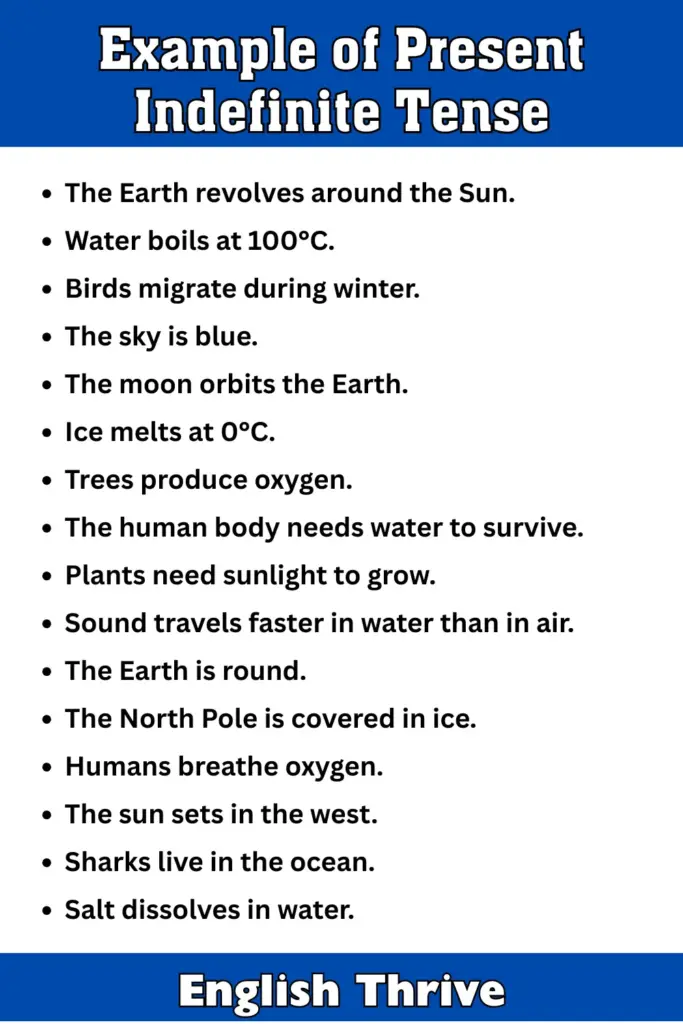The present indefinite tense, also known as the simple present tense, is one of the most commonly used tenses in English grammar. It is used to describe actions that occur regularly, facts, general facts, and habitual actions. The structure of this tense is simple, which makes it easy to understand and use in everyday situations.
In this blog post, we will discuss the Example of Present Indefinite Tense in depth,usage rules, and common mistakes so that you can master it.
Contents
ToggleWhat is the Present Indefinite Tense?
The Present Indefinite Tense is used to express actions that are habitual or occur regularly. It is also used to state facts, express general truths, and describe scheduled events. This tense is formed using the base form of the verb for all subjects, with the exception of the third-person singular, where we add ‘-s’ or ‘-es’ to the verb.
Uses of Present Indefinite Tense:
- Habitual Actions: Actions that happen regularly.
- Example: “She plays tennis every weekend.”
- General Truths: Facts that are universally true.
- Example: “The sun rises in the east.”
- Scheduled Events: Events scheduled to happen at a specific time in the future.
- Example: “The train leaves at 6 p.m.”
- Instructions or Directions: Giving clear instructions or directions.
- Example: “You take the first right, then go straight.”
- Feelings or Opinions: Expressing general opinions or emotions.
- Example: “I love reading books.”
Structure of the Present Indefinite Tense
To expert the present indefinite tense, you need to understand its structure in positive, negative, and question forms.
Positive Sentences:
- Form: Subject + Base Verb (add -s or -es for third-person singular subjects)
- Example: “She sings beautifully.”
- Example: “They play football every weekend.”
Negative Sentences:
- Form: Subject + do/does + not + Base Verb
- Example: “He does not like vegetables.”
- Example: “They do not attend the meeting regularly.”
Questions:
- Form: Do/Does + Subject + Base Verb
- Example: “Do you like chocolate?”
- Example: “Does she study French?”

Examples of Present Indefinite Tense
To further solidify your understanding, let’s look at some examples of the present indefinite tense in different categories
Examples of General Facts and Truths
- The Earth revolves around the Sun.
- Water boils at 100°C.
- Birds migrate during winter.
- The sky is blue.
- The moon orbits the Earth.
- Ice melts at 0°C.
- Trees produce oxygen.
- The human body needs water to survive.
- Plants need sunlight to grow.
- Sound travels faster in water than in air.
- The heart pumps blood throughout the body.
- The Earth is round.
- The North Pole is covered in ice.
- Humans breathe oxygen.
- The sun sets in the west.
- Sharks live in the ocean.
- Salt dissolves in water.
- A year consists of 365 days.
- Rain falls from clouds.
- The seasons change every year.
Examples of Habitual Actions
- I wake up at 6 a.m. every day.
- She drinks coffee in the morning.
- They go to the gym three times a week.
- He reads the newspaper every day.
- We visit our grandparents on Sundays.
- She brushes her teeth twice a day.
- They play basketball after school.
- He always eats lunch at noon.
- I take a walk every evening.
- We have a meeting every Monday.
- She practices piano for an hour every day.
- They study English in the evening.
- I write in my journal every night.
- We walk to work together.
- He checks his email every morning.
- I call my mom every Friday.
- They arrive at work at 9 a.m.
- She reads a book before bed.
- We have dinner together as a family every evening.
- He takes a shower after the gym.
Examples of Scheduled Events
- The bus leaves at 7 a.m.
- The meeting starts at 3 p.m.
- Our class begins tomorrow.
- The store opens at 8 a.m.
- The movie starts at 9 p.m.
- The train departs at 10:30 a.m.
- The conference starts next Monday.
- Our flight leaves at 6 p.m.
- The concert begins at 8 o’clock.
- The event ends at 5 p.m.
- My appointment is at 2 p.m.
- The show airs every Tuesday.
- The office closes at 5:30 p.m.
- The shop opens at 9 a.m. every day.
- The festival lasts three days.
- The restaurant serves lunch at noon.
- The exhibition opens next week.
- The public transport operates from 7 a.m. to 10 p.m.
- The new season of the series releases on Friday.
- Our team plays at home this Saturday.

How to Form Present Indefinite Tense Sentences
Now that you understand the structure and usage of the Present Indefinite Tense, let’s explore how to form sentences in this tense. The key is in its simplicity, as the base verb is used in most cases. Below, I will break down how to create affirmative, negative, and question forms.
Affirmative Sentences (Positive Sentences)
To form a positive sentence in the Present Indefinite Tense, you need the subject followed by the base verb. If the subject is third-person singular (he, she, or it), simply add -s or -es to the verb.
- Structure: Subject + Base Verb (+ ‘-s’ or ‘-es’ for third-person singular)
Examples:
- She works at a hospital.
- They play soccer every Sunday.
- I like reading books.
- We walk to school every day.
- He writes in his diary every night.
- The sun rises in the east.
- She sings in the choir.
- I study English every morning.
- They watch movies on Fridays.
- He speaks French fluently.
- We enjoy swimming in the pool.
- She runs every morning.
- I cook dinner every night.
- They practice yoga regularly.
- The teacher explains the lesson clearly.
- The dog barks loudly.
- She enjoys painting.
- He listens to music while working.
- We visit the library every weekend.
- The birds chirp in the morning.
Negative Sentences
In negative sentences, the helping verb ‘do’ (or ‘does’ for third-person singular) is used before the main verb. Add ‘not’ after ‘do’/‘does’ to negate the action.
- Structure: Subject + do/does + not + Base Verb
Examples:
- I do not like coffee.
- She does not go to the gym on weekends.
- They do not watch TV in the morning.
- He does not speak Italian.
- We do not eat meat.
- She does not study on Sundays.
- They do not play basketball after school.
- He does not visit his parents regularly.
- I do not watch the news in the morning.
- We do not drive to work every day.
- The teacher does not give homework on weekends.
- They do not like spicy food.
- I do not agree with you.
- She does not enjoy watching horror movies.
- He does not work on weekends.
- They do not attend the meeting.
- We do not go out for lunch.
- The cat does not like water.
- I do not speak French.
- She does not take the bus to school.
Questions
To form questions, we use ‘do’ or ‘does’ (for third-person singular) at the beginning of the sentence. The subject follows the helping verb, and the main verb stays in its base form.
- Structure: Do/Does + Subject + Base Verb
Examples:
- Do you like chocolate?
- Does she read books before bed?
- Do they play tennis every weekend?
- Does he speak English fluently?
- Do we need to buy tickets for the event?
- Does it rain often in your city?
- Do you study for exams regularly?
- Does she enjoy watching movies?
- Do they eat dinner together?
- Does he live in London?
- Do we have class today?
- Does she work at this company?
- Do you know where the nearest store is?
- Does your brother play the guitar?
- Do they visit their grandparents often?
- Does he play video games?
- Do you walk to school?
- Does she take the bus to work?
- Do we get a break at noon?
- Does your sister like to dance?
Common Mistakes in the Present Indefinite Tense
Even though the Present Indefinite Tense is simple, there are some common mistakes learners tend to make. Let’s explore some of them:
1. Incorrect Verb Forms with Third-Person Singular Subjects:
For third-person singular subjects (he, she, it), we need to add ‘-s’ or ‘-es’ to the verb. Forgetting to do this is a common error.
- Incorrect: “She play the guitar.”
- Correct: “She plays the guitar.”
2. Misuse of ‘Do’ and ‘Does’:
When forming negative sentences or questions, we often misuse ‘do’ and ‘does’.
- Incorrect: “He do not like pizza.”
- Correct: “He does not like pizza.”
3. Confusing the Use of ‘Do’ and ‘Does’ with Plural Subjects:
Remember that we only use ‘does’ for third-person singular subjects. For plural subjects, we use ‘do’.
- Incorrect: “They does not know the answer.”
- Correct: “They do not know the answer.”
4. Using Present Indefinite Tense Instead of Present Continuous Tense:
Sometimes learners use the Present Indefinite Tense when the Present Continuous Tense is required to express actions happening at the moment.
- Incorrect: “She eats her lunch now.”
- Correct: “She is eating her lunch now.”
5. Forgetting to Use ‘Do’ or ‘Does’ in Questions:
When forming questions, the ‘do/does’ helping verb should not be omitted.
- Incorrect: “She go to the market?”
- Correct: “Does she go to the market?”
FAQs about Example of Present Indefinite Tense
Let’s now dive into some common questions people often have regarding the Present Indefinite Tense. Understanding these can help clarify any doubts you might have.
1. What is the Present Indefinite Tense?
The Present Indefinite Tense is used to describe actions that occur regularly, general truths, facts, or scheduled events. It is also used to express habits and routines. This tense is formed with the base form of the verb for most subjects, and ‘-s’ or ‘-es’ is added for third-person singular subjects (he, she, it).
Example:
- “She works at a hospital.” (habitual action)
- “The sun rises in the east.” (general truth)
2. What are 10 examples of Present Indefinite Tense?
Here are 10 clear examples of the Present Indefinite Tense:
- I eat breakfast every day.
- She plays the piano every evening.
- They visit their friends on weekends.
- We go to the gym every morning.
- He drinks coffee in the morning.
- The Earth revolves around the Sun.
- She likes to read before bed.
- I study English every day.
- They walk to school every day.
- He speaks three languages.
3. How do I know when to use Present Indefinite Tense?
Use the Present Indefinite Tense when:
- Describing regular or habitual actions.
- Stating general facts or truths.
- Expressing scheduled events (future, but fixed).
- Giving instructions or directions.
- Expressing likes, dislikes, and preferences.
Example:
- “I always wake up at 7 a.m.” (habit)
- “The sun rises in the east.” (fact)
- “The train departs at 9 a.m.” (scheduled event)
4. What is the rule for Present Indefinite Tense?
The rule for forming sentences in the Present Indefinite Tense is quite simple:
- For positive sentences: Use the base form of the verb (add ‘-s’ or ‘-es’ for third-person singular subjects).
- Example: “He plays football.”
- For negative sentences: Use ‘do/does’ (for third-person singular) + ‘not’ + base verb.
- Example: “They do not watch TV.”
- For questions: Use ‘do/does’ at the beginning of the sentence, followed by the subject and then the base verb.
- Example: “Do you like ice cream?”
How to Practice Present Indefinite Tense
To get better at using the Present Indefinite Tense, practice is key. Here are a few tips for practicing:
- Daily Routine Exercises: Describe your daily activities using the Present Indefinite Tense.
- Example: “I wake up at 7 a.m., I brush my teeth, and I go for a jog.”
- Write Sentences: Try to write 10 sentences every day using the Present Indefinite Tense. Focus on habits, facts, and general truths.
- Use Flashcards: Create flashcards with verbs, and then form sentences in the Present Indefinite Tense using those verbs.
- Practice with Questions: Form questions using ‘do’ and ‘does’. Practice asking and answering questions with family or friends.
- Example: “Do you like traveling?”
- Engage in Conversations: Try to speak with others about your routines, hobbies, or general knowledge to practice the tense in context.
Conclusion
Understanding the examples of present indifinite tense with details helps improve your English grammar. Its simple structure and various uses—from talking about habits and facts to expressing scheduled events—make it a key part of everyday communication.
By practicing the examples and rules we’ve covered, you can use the Present Indefinite Tense in both speech and writing. Whether you’re talking about your daily routine, sharing facts, or asking questions, this tense will help you communicate more clearly.

